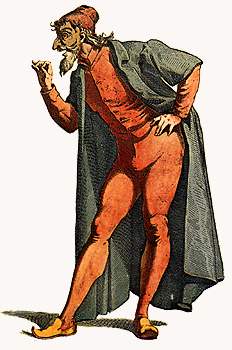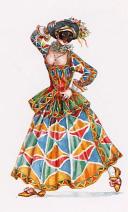Create a Commedia Dell’Arte Character
Commedia dell’arte is an improvised comedic theatre form that flourished in Italy in the 1500’s. The exact origins of Commedia are fuzzy and hard to pin down. There is not much documented previous to the 16th century. The term itself (Commedia dell’arte) wasn’t put to common use until the 18th century. It is generally acknowledged that the form solidified in Italy in the 1550’s and reached its peak in the 1650’s.
Despite an opaque history, the elements that define Commedia are quite clear:
- improvised performances based on scenarios – actors worked off a base outline and made up their lines.
- stock characters – the characters were always the same, only the situations changed.
- limited themes – love, money, or food were the base of almost every scenario.
- use of mask – the mask defined the characters.
- use of lazzi – short comedic physical bits within the story.
- use of mime , acrobatics, and music.
The key to creating a Commedia character is to remember that they are stock characters. In every scenario or story they’re in, the characters remain the same. They have the same attitude, the same look, the same drive, the same physical action.
That means you would be able to recognize a Commedia stock character in an instant by how they move, what they wear, and how they act.
Creating A Commedia Character: Step One
What category will you choose?
Commedia characters are fixed types who fall into one of three categories:
- The Servants (eg: Arlecchino or Columbina)
- The Masters (eg: Pantalone)
- The Lovers (eg: Isabella and Flavio )
The masters are usually foolish greedy old men, and the servants are hungry and mischievous. The young lovers are always in love. Most of the characters wear masks, but even those without masks (e.g. the Lovers) treat their personas as masks. In Commedia, the characteristics of a character (such as a walk, a pose, or a gesture) are just like wearing a mask.
Creating a Commedia Character: Step Two
Pick a character
After you choose a category, you need to choose a character. Each character has defined attributes that never change. So you’re not creating a new commedia character, you’re choosing an existing character and inhabiting his or her attributes.
Here are a couple of examples.
The Masters
Pantalone
Description: Old Venetian Merchant. Rich and greedy miser. Obsessed with money. Always after women and thinks he’s good at it. Gullible and often tricked.
Costume: Red pants and top with a flowing black cloak. Has a money bag.
Mask: Long pointed nose. Often has a moustache and bushy eyebrows.
Movement: Leads with the forehead and has a hunched back with bent knees. Think crow or chicken. Fluttery hands, which he tries to contain by clasping them behind his back. Always bent over, trying to keep his money safe!
The Servants
Arlecchino
Description: Servant, poor, always wanting money, always hungry. Carries a bat/slapstick. Stupid and smart at the same time. Doesn’t want to work but eager to please.
Costume: Tight fitting patchwork/colourful costume.
Mask: Black mask. Small eyes. Catlike face.
Movement: Low status. Very acrobatic and quick. Leads with his knees and is very active, always on the move, never moving in a straight line. Think monkey.
Columbina
Description: Servant. Name means Little Dove. A female version of Arlecchino – quick wit, vain, never in love. She is often spiteful. Often a servant to Isabella, an Innamorata. Usually the smartest character on stage.
Costume: Often dressed in similar colours to Arlecchino. Cap and apron. Dressed as a lady’s maid.
Mask: Sometimes she wears a mask and sometimes not. If she does, it’s a small one that only covers the eyes.
Movement: Though she’s a servant, and therefore low status, her movements correspond to her strong, quick-witted character. She stands with a hip cocked to the side, hands on hips. She moves with quick, strong steps.
The Lovers
Isabella and Flavio
Description: These characters are very much in love with love. They love each other, they love themselves. They carry mirrors so that they can look at themselves as often as possible. They act completely over the top in their infatuations (like Soap Opera characters). They have no notion of the consequences of their actions, nor are they all that bright.
Costume: Think Italian Renaissance Princes and Princesses. They are covered head to toe, perhaps excessively, in the best fashions and finery.
Mask: They don’t wear masks, but do wear makeup. They are always young and attractive.
Movement: High status. Whatever they do, it’s melodramatic and over the top. They glide instead of walk. They don’t stand, they pose. They show pride in every move they make.
Creating A Commedia Character: Step Three
Define the Physical
You have a category and a character. Your next step is to define that character. Practice the pose, the gestures and the movements of your character. Anyone watching should be able to identify your chosen character.
Exercise: Divide students into pairs. The pairs have to identify the physical characteristics of their chosen character and write them down. Then students practice the pose, gestures and movements of their character. Partner A takes on their persona while Partner B observes. Partner A is to walk around the room, sit, stand, interact with objects – all in character. It is Partner B’s job to identify when Partner A strays from the character. The pairs then switch. Partner B takes on their persona and Partner A observes. The pairs switch back and forth in order to practice the character fully.
At the end of a designated period of time, turn this from a pairs exercise into a full class exercise. Everyone moves about the room at the same time (in character) and starts to interact with each other. Remind students of their status. If they are playing a master character, how do they treat the servants? If they are a servant character, how are they going to treat The Lovers? What is their defined personality trait?
Once everyone is comfortable moving in character, have students interact in character. Get them to greet each other, talk about the weather, engage in small talk. They have to stay in character and they have to react to each other according to their status. How would a servant talk to a master? How would a master talk to one of the lovers?
Creating A Commedia Character: Step Four
Create a Lazzi
Every commedia actor has a number of lazzi in their repertoire. A lazzi is a physical comedic bit in the middle of the play, unrelated to the plot. The three main themes for Commedia are love, money and food in the extreme – so that means lazzi are also taken to the extreme. They are acrobatic, exaggerated, and sometimes obscene.
Once students have fully practiced the physical side to their character, give them this lazzi to create.
The Lazzi of the sandwich
Your character enters a room. On a table in the centre of the room, there is a beautiful sandwich. It has a number of layers. It smells delicious. It looks perfect. It does not belong to your character, but you are so hungry and you want that sandwich. In character, examine the room. Is the owner of the sandwich nearby? You approach the sandwich. Interact with the sandwich. And eat the sandwich. You look around the room and leave.
Remind students that they have to stay in character at all times. The point of the exercise is to show how their character would interact with a sandwich. How Pantalone completes this exercise would be different than the way Columbina completes it or one of the lovers.
Keep students in pairs, so that one partner is always observing the other. Give students time to rehearse and then present.





